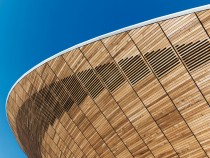
© Richard Davies
The velodrome for the 2012 Olympic Games in London is an elegantly curved shell structure with seating for 6,000 spectators. The overall form is divided horizontally into two parts. Enclosed within an earth embankment, the plinth bears the two upward curving ends of the cycle-racing track and houses the lower stands plus all functional spaces. A glazed circulation zone separates this from the timber-clad shell at the top, the form of which was determined by the sight lines from the upper tiers of seating on the two long sides of the track. Here, a 22-metre-high, broadly canti-levered structure is generated. In contrast, the edge of the roof next to the curves of the track dips far down to a level just above the circulation zone. The roof, with its double reverse curves, is supported by a cable-net structure, the tensile forces from which are transmitted to steel trussed girders that follow the line of the outer edge. Hollow timber elements, laid out to a 3.60-metre grid and supported on every cable node, bear an aluminium standing-seam roofing system. Top lights minimize the need for electric lighting. Compared with a conventional trussed-girder system, the present structure, consisting of tension elements and a compression ring, helped save roughly 1,000 tonnes of steel. The architects show that a dynamic form and intelligent construction need not be mutually exclusive. The structure is a fitting analogy with the spokes and rim of a bicycle wheel.





